 Luxury brands have a vast social media landscape to navigate. Image credit: Luxury Society
Luxury brands have a vast social media landscape to navigate. Image credit: Luxury Society
It is no secret that social media has had arguably the biggest disruptive effect on the way brands interact with customers of the last decade, and a few major platforms have emerged as the premier places where that interaction now occurs. While there are many social media platforms, a few have proven so popular and all-encompassing that they make up the majority of all brand-customer social relations. From Facebook and Instagram to Twitter and even Snapchat, brands need to understand how best to navigate the specific intricacies of each platform if they want to be successful in competing for customers’ limited time and attention. "At a high level, we’ve seen many luxury brands prioritize social more than in the past, so we’re seeing a surge in marketing spend and additional creative testing on social platforms," said Andrea Wilson, vice president/strategy director and luxury practice lead at iProspect, Fort Worth, TX. "We’ve also seen a shift in where campaigns are centered, with the majority of storytelling starting with social and build in ways that are easy for core consumers to ingest," she said. Top 5 trends in social media platforms:
- Influencers One of the biggest trends in social media today is the use of influencers. Social media is built on personalities and individuals and by tapping into the huge audiences that popular individuals hold on social media, especially through Instagram, brands have access to a large number of customers who place a great deal of trust in the influencers they follow.
- Live video Social media has always been immediate, and live video is making immediacy even more important for brands and consumers alike. From Facebook Live to Twitter’s heavy investment in Periscope, live video and live streaming through social media allows for an intimacy and immediacy that scripted and pre-filmed video does not.
- Native content Today’s consumers are weary of advertising and they can easily become resentful or apathetic toward brands that saturate their feeds with intrusive marketing campaigns. Native content has emerged as a positive solution to this problem, allowing brands to create content that provides real value to customers and gets smoothly integrated into their social media feeds without fuss.
- Attribution One of the Holy Grails that many marketers and brands search for in the modern era is the ability to accurately attribute digital ads to physical sales. Social media has proven to be one of the best ways of doing this. For instance, Snapchat’s Snap to Store program was designed specifically to make this attribution, and other social media platforms are following suit.
- Cohesive messaging Consumers live their digital lives across social media platforms and when there are a number of those platforms in play, brands must keep their messaging consistent. While each platform may provide unique opportunities and features, brands must make sure that the experience consumers have with the brand is consistent across all platforms.
 Mobile conversions will be at an all-time-high this holiday season. Image courtesy of Facebook
During Facebook’s “Holiday Preview” press brunch June 27, two executives shared holiday trends, research and predictions, as well as new tools created by the social network to drive sales this upcoming holiday season. Although consumers tend to only start shopping in October, 69 percent of marketers begin planning for the holiday rush in August, taking a “never too early” approach to the gifting season (see story).
Brands have already begun to reap the rewards of Facebook’s improved ad targeting abilities.
For example, Italian automaker Maserati recently wielded Facebook's advertising capability to drive direct sales for its Levante SUV, leveraging custom audiences and data-driven pushes.
Maserati saw 127 vehicles sold directly from its recent two-phase Facebook campaign that built a targeted audience for those most likely to engage with the ads. The brand worked with outside data to discover Facebook users that were luxury SUV shoppers (see story).
One of the biggest additions to Facebook’s arsenal of tools for brands is Facebook Messenger and its associated chatbots.
These chatbots allow brands to connect with consumers on a more personal level while their automated nature frees up manpower for more nuanced interactions.
Italian apparel and accessories brand Giorgio Armani looked to make a dramatic impact with its third annual film project with the help of a special bot that went beyond commerce.
Facebook Messenger bots have become increasingly popular in the luxury space. While many brands hope to leverage chatbots for retail initiatives such as driving sales and bookings, Armani took an opportunity to assist consumers interested in its "Films of City Frames" project to make a bigger impact (see story).
Mobile conversions will be at an all-time-high this holiday season. Image courtesy of Facebook
During Facebook’s “Holiday Preview” press brunch June 27, two executives shared holiday trends, research and predictions, as well as new tools created by the social network to drive sales this upcoming holiday season. Although consumers tend to only start shopping in October, 69 percent of marketers begin planning for the holiday rush in August, taking a “never too early” approach to the gifting season (see story).
Brands have already begun to reap the rewards of Facebook’s improved ad targeting abilities.
For example, Italian automaker Maserati recently wielded Facebook's advertising capability to drive direct sales for its Levante SUV, leveraging custom audiences and data-driven pushes.
Maserati saw 127 vehicles sold directly from its recent two-phase Facebook campaign that built a targeted audience for those most likely to engage with the ads. The brand worked with outside data to discover Facebook users that were luxury SUV shoppers (see story).
One of the biggest additions to Facebook’s arsenal of tools for brands is Facebook Messenger and its associated chatbots.
These chatbots allow brands to connect with consumers on a more personal level while their automated nature frees up manpower for more nuanced interactions.
Italian apparel and accessories brand Giorgio Armani looked to make a dramatic impact with its third annual film project with the help of a special bot that went beyond commerce.
Facebook Messenger bots have become increasingly popular in the luxury space. While many brands hope to leverage chatbots for retail initiatives such as driving sales and bookings, Armani took an opportunity to assist consumers interested in its "Films of City Frames" project to make a bigger impact (see story).
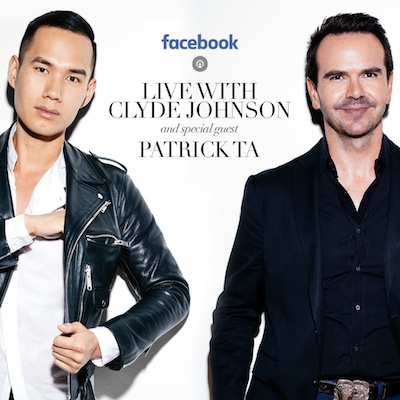 La Mer's Facebook Live chat. Image credit: La Mer
The social media giant’s live video efforts have been particularly notable in recent months. Facebook Live has taken off as a viable way for both brands and regular users to keep each other up to date with events as they happen.
Condé Nast-owned Vogue was on-site for the first Monday in May this year to provide its readership with live coverage of the annual Met Gala.
This year’s Met Gala: The Art of the In-Between was held on the evening of Monday, May 1 and was a celebration of Japanese designer Rei Kawakubo, founder of Comme des Garçons. Ms. Kawakubo was the first living designer as the subject of the exhibition since Yves Saint Laurent in 1983 (see story).
Similarly, Estée Lauder Cos.’ Crème de la Mer turned to Facebook Live to decode summer beauty with one of its newly appointed brand ambassadors, Patrick Ta.
Mr. Ta, a self-taught beauty expert discovered on Instagram, along with Hollywood veteran Kayleen McAdams and Parisian makeup artist Violette, were chosen as La Mer’s first official brand ambassadors. At the time, La Mer only offered high-end skincare products and a beauty line was on the way, hence linking with three beauty gurus ahead of the fall collection launch was a strategic move (see story).
Retailer Matches Fashion leveraged Facebook Live to bring to life a three-day events series last year at New York’s WOM Townhouse.
Matches Fashion set up its residency at 214 Lafayette Street in April of last year and broadcast the weekend’s happenings to a global audience. Facebook Live allows followers access to exclusive events, regardless of location, to increase interaction and engagement with brands in real time (see story).
With the plethora of options that Facebook allows for brands to engage with customers, the platform is one of the most important players in the digital world today.
The Twitterverse
Of the four biggest social platforms for brands, Twitter is arguably one of the more difficult to categorize.
While Facebook, Instagram and Snapchat all excel at visual marketing with videos and images taking center stage, Twitter’s focus on text above all else means that brands have a slightly harder time catching the attention of customers.
What this affords, however, is the ability for brands to have more in depth conversations with customers, allowing them to engage with those customers on a deeper level than can simply be expressed in an Instagram comment, for instance.
Take Kering, for example. The conglomerate created a conversation before December’s Sustainable Innovation Forum 2015 through a Twitter talk on environmental issues.
La Mer's Facebook Live chat. Image credit: La Mer
The social media giant’s live video efforts have been particularly notable in recent months. Facebook Live has taken off as a viable way for both brands and regular users to keep each other up to date with events as they happen.
Condé Nast-owned Vogue was on-site for the first Monday in May this year to provide its readership with live coverage of the annual Met Gala.
This year’s Met Gala: The Art of the In-Between was held on the evening of Monday, May 1 and was a celebration of Japanese designer Rei Kawakubo, founder of Comme des Garçons. Ms. Kawakubo was the first living designer as the subject of the exhibition since Yves Saint Laurent in 1983 (see story).
Similarly, Estée Lauder Cos.’ Crème de la Mer turned to Facebook Live to decode summer beauty with one of its newly appointed brand ambassadors, Patrick Ta.
Mr. Ta, a self-taught beauty expert discovered on Instagram, along with Hollywood veteran Kayleen McAdams and Parisian makeup artist Violette, were chosen as La Mer’s first official brand ambassadors. At the time, La Mer only offered high-end skincare products and a beauty line was on the way, hence linking with three beauty gurus ahead of the fall collection launch was a strategic move (see story).
Retailer Matches Fashion leveraged Facebook Live to bring to life a three-day events series last year at New York’s WOM Townhouse.
Matches Fashion set up its residency at 214 Lafayette Street in April of last year and broadcast the weekend’s happenings to a global audience. Facebook Live allows followers access to exclusive events, regardless of location, to increase interaction and engagement with brands in real time (see story).
With the plethora of options that Facebook allows for brands to engage with customers, the platform is one of the most important players in the digital world today.
The Twitterverse
Of the four biggest social platforms for brands, Twitter is arguably one of the more difficult to categorize.
While Facebook, Instagram and Snapchat all excel at visual marketing with videos and images taking center stage, Twitter’s focus on text above all else means that brands have a slightly harder time catching the attention of customers.
What this affords, however, is the ability for brands to have more in depth conversations with customers, allowing them to engage with those customers on a deeper level than can simply be expressed in an Instagram comment, for instance.
Take Kering, for example. The conglomerate created a conversation before December’s Sustainable Innovation Forum 2015 through a Twitter talk on environmental issues.
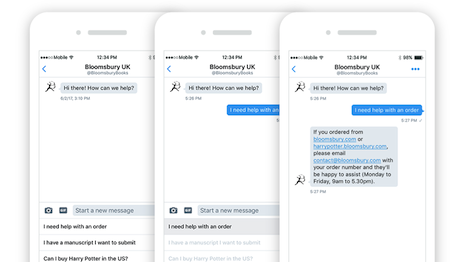 Twitter chatbots. Image credit: Sprout Social
The #KeringLive event in November 2015 covered topics that specifically impact the fashion industry, allowing participants to discuss challenges and share best practices with their peers. This effort at opening a dialogue between members of the fashion industry followed the concept of Kering’s open-source report released earlier that year (see story).
Some brands have struggled with building an engaging rapport with consumers through Twitter, however.
With 1.4 million Twitter followers, U.S. jewelry brand Tiffany & Co. places first among the top 10 jewelers on the social media platform, per Digital Luxury Group.
Despite many industry insiders and consumers alike feeling that Twitter’s heyday is quickly declining, the platform presents brands with an opportunity to both inspire and inform, blending the strengths of Facebook and Instagram. Digital Luxury Group worked with Luxury Society to identify which jewelry and watch brands are excelling on Twitter based on community size and engagement (see story).
But Twitter has been working hard to craft more tools for brands to engage with consumers through the platform.
One tool that has seen increased usage over the last year or so is the branded emoji, a unique emoji that automatically displays alongside certain hashtags, usually promoted by a brand.
Twitter’s $1 million price tag for branded emojis during the Super Bowl suggests takers such as Anheuser-Busch and PepsiCo see significant value in the still-new marketing tactic, but others should get a handle on measurement before diving in.
Twitter chatbots. Image credit: Sprout Social
The #KeringLive event in November 2015 covered topics that specifically impact the fashion industry, allowing participants to discuss challenges and share best practices with their peers. This effort at opening a dialogue between members of the fashion industry followed the concept of Kering’s open-source report released earlier that year (see story).
Some brands have struggled with building an engaging rapport with consumers through Twitter, however.
With 1.4 million Twitter followers, U.S. jewelry brand Tiffany & Co. places first among the top 10 jewelers on the social media platform, per Digital Luxury Group.
Despite many industry insiders and consumers alike feeling that Twitter’s heyday is quickly declining, the platform presents brands with an opportunity to both inspire and inform, blending the strengths of Facebook and Instagram. Digital Luxury Group worked with Luxury Society to identify which jewelry and watch brands are excelling on Twitter based on community size and engagement (see story).
But Twitter has been working hard to craft more tools for brands to engage with consumers through the platform.
One tool that has seen increased usage over the last year or so is the branded emoji, a unique emoji that automatically displays alongside certain hashtags, usually promoted by a brand.
Twitter’s $1 million price tag for branded emojis during the Super Bowl suggests takers such as Anheuser-Busch and PepsiCo see significant value in the still-new marketing tactic, but others should get a handle on measurement before diving in.
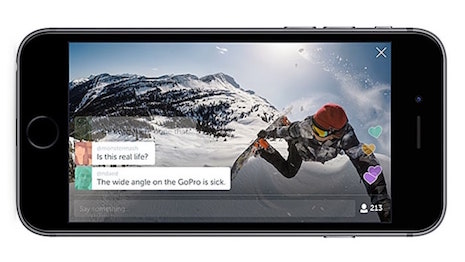 360-degree live video. Image credit: Twitter
The two big marketers are likely to receive a big awareness pop during the Super Bowl on Twitter through the new emojis, but not necessarily due to the big event, but because the idea is still new to users. For other marketers thinking of foraying into Twitter’s emojis, it is vital to think about how to effectively measure its reach and return on investment (see story).
"To make the use of Twitter count, play up the strengths of the platform: one-on-one conversation, behind-the-scenes and customer service," said Brian Honigman, CEO of Honigman Media, New York. "For example, a one-to-one conversation with the brand to its customers can strengthen the loyalty a consumer has since they are connecting with the brand directly, but, many will struggle to do this in the luxury sector as giving up control of a perfectly polished brand is harder for some than others.
"A conversation is unpredictable, which is why most luxury brands have a one-way monologue instead of a dialogue with customers," he said. "If your brand struggles with this, partner with a brand advocate internally or externally to chat with customers on your behalf on Twitter for a scheduled Q&A.
"This way you're able to have a conversation, but with some specific constraints around the format."
On the video front, Twitter has made extensive headway, bringing 360-degree video to the fold earlier this year, making it one of the first social media platforms to do so after Facebook.
Twitter is offering the ability to record live video in an immersive 360-degree format to “select partners” of its streaming application, Periscope.
The feature, which debuted this week, allows all users to view the 360-degree videos, and works similarly to analog products at YouTube and Facebook. It is also the company’s highest profile investment in its Periscope property this year, a year which it began as the subject acquisition talks and ended with a bloodletting of talent, including the departures of chief technology officer Adam Messenger and vice president of product Josh McFarland (see story).
With Twitter facing an ongoing challenge driving usage rates, the company is investing heavily in live streaming platform Periscope to drive engagement and ad revenue as video use continues to grow.
360-degree live video. Image credit: Twitter
The two big marketers are likely to receive a big awareness pop during the Super Bowl on Twitter through the new emojis, but not necessarily due to the big event, but because the idea is still new to users. For other marketers thinking of foraying into Twitter’s emojis, it is vital to think about how to effectively measure its reach and return on investment (see story).
"To make the use of Twitter count, play up the strengths of the platform: one-on-one conversation, behind-the-scenes and customer service," said Brian Honigman, CEO of Honigman Media, New York. "For example, a one-to-one conversation with the brand to its customers can strengthen the loyalty a consumer has since they are connecting with the brand directly, but, many will struggle to do this in the luxury sector as giving up control of a perfectly polished brand is harder for some than others.
"A conversation is unpredictable, which is why most luxury brands have a one-way monologue instead of a dialogue with customers," he said. "If your brand struggles with this, partner with a brand advocate internally or externally to chat with customers on your behalf on Twitter for a scheduled Q&A.
"This way you're able to have a conversation, but with some specific constraints around the format."
On the video front, Twitter has made extensive headway, bringing 360-degree video to the fold earlier this year, making it one of the first social media platforms to do so after Facebook.
Twitter is offering the ability to record live video in an immersive 360-degree format to “select partners” of its streaming application, Periscope.
The feature, which debuted this week, allows all users to view the 360-degree videos, and works similarly to analog products at YouTube and Facebook. It is also the company’s highest profile investment in its Periscope property this year, a year which it began as the subject acquisition talks and ended with a bloodletting of talent, including the departures of chief technology officer Adam Messenger and vice president of product Josh McFarland (see story).
With Twitter facing an ongoing challenge driving usage rates, the company is investing heavily in live streaming platform Periscope to drive engagement and ad revenue as video use continues to grow.
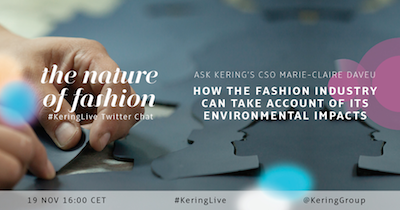 Kering Twitter talk. Image credit: Kering
While monthly active use was down in the fourth quarter, the total number of advertisers totaled 130,000, up almost 90 percent year-over-year and advertising revenue totaled $641 million, up 48 percent. Twitter has a number of new initiatives in the market or planned in an attempt to lure brands that are increasingly looking to spread around their dollars earmarked for social beyond just Facebook (see story).
Finally, Twitter has followed Facebook’s model in bringing automated chatbots to the platform specifically for brands to better handle everyday communications with consumers.
Consumers are flocking to social media to have customer service queries answered, and brands and Twitter are responding by making the process more seamless.
Twitter has released a bot builder in which brands such as idea-sharing platform Evernote and the United Kingdom's Monarch Airlines are using to answers customer questions. Through direct messaging on Twitter, these bots will help answer these issues and direct the query to the correct department (see story).
Overall, Twitter offers brands a wide number of tools to help make communication with consumers simpler and quicker. Where it lacks in terms of actual content, it makes up for in immediacy and transparency.
Instagram-worthy content
Facebook-owned Instagram has already been singled out by many brands as one of the top platforms for branded content.
Instagram has a huge user base of highly engaged consumers, a wide variety of tools for brands to create and push content as well as large communities built around individuals who command enormous influence over their followers.
All put together, Instagram has been one of the biggest players in the social media space for brands.
Instagram has become the fastest-growing mobile application, and today it counts 800 million active monthly users, 80 percent of whom are living outside of the United States.
The social media platform has outpaced magazines as the source of consumers’ inspiration, with U.S. consumers more apt to look at Instagram than glossies to find ideas, according to a Facebook-sponsored study by Kantar Millward Brown (see story).
Kering Twitter talk. Image credit: Kering
While monthly active use was down in the fourth quarter, the total number of advertisers totaled 130,000, up almost 90 percent year-over-year and advertising revenue totaled $641 million, up 48 percent. Twitter has a number of new initiatives in the market or planned in an attempt to lure brands that are increasingly looking to spread around their dollars earmarked for social beyond just Facebook (see story).
Finally, Twitter has followed Facebook’s model in bringing automated chatbots to the platform specifically for brands to better handle everyday communications with consumers.
Consumers are flocking to social media to have customer service queries answered, and brands and Twitter are responding by making the process more seamless.
Twitter has released a bot builder in which brands such as idea-sharing platform Evernote and the United Kingdom's Monarch Airlines are using to answers customer questions. Through direct messaging on Twitter, these bots will help answer these issues and direct the query to the correct department (see story).
Overall, Twitter offers brands a wide number of tools to help make communication with consumers simpler and quicker. Where it lacks in terms of actual content, it makes up for in immediacy and transparency.
Instagram-worthy content
Facebook-owned Instagram has already been singled out by many brands as one of the top platforms for branded content.
Instagram has a huge user base of highly engaged consumers, a wide variety of tools for brands to create and push content as well as large communities built around individuals who command enormous influence over their followers.
All put together, Instagram has been one of the biggest players in the social media space for brands.
Instagram has become the fastest-growing mobile application, and today it counts 800 million active monthly users, 80 percent of whom are living outside of the United States.
The social media platform has outpaced magazines as the source of consumers’ inspiration, with U.S. consumers more apt to look at Instagram than glossies to find ideas, according to a Facebook-sponsored study by Kantar Millward Brown (see story).
 Instagram is a source of inspiration. Image credit: Bloomingdale's
One of the platform’s best tools right now is Instagram Stories, short videos and images that can be pinned to a brand’s account for a limited time and can be engaged with by consumers on a quick and immediate level.
In addition to just viewing the content, Stories can be made shoppable and interactive through quick swipes that can take users to whatever page the brand deems appropriate.
Initial engagement and interaction on Instagram Stories – 200 million consumers are using the feature daily – has proven that consumer adoption is exceptionally promising, and the opportunity for brands to capitalize on such engagement seems to be growing by the minute.
According to Instagram internal data, 70 percent of Instagrammers follow a business, one in five stories on Instagram receive a direct message from viewers and one-third of the most viewed stories are from businesses. So, brands need to act now, or risk becoming obsolete in an ever-evolving social sphere of influence (see story).
A quick survey of the landscape shows that many brands are already taking advantage of Instagram Stories.
U.S. lifestyle brand Ralph Lauren wove an interactive story leading up to its New York Fashion Week presentation through Instagram, intertwining storytelling with see-now, buy-now, as well as behind-the-scenes content.
The designer took on two rising trends in fashion week, hosting its runway presentation outside of New York and focusing on see-now, buy-now. However, Ralph Lauren is making a stronger impact with its use of Instagram Stories and unique interpretations of the trends (see story).
Instagram has released the top fashion industry users in terms of engagement through stories, with very few brands making the list. However, Dior, Louis Vuitton, Dolce & Gabbana and Christian Louboutin were ranked extremely high on the list.
The rankings come from a list of the accounts that see the most number of views on their stories from accounts with more than 10 million followers. The organic nature of content from brands solidifies a more personal connection with consumers rather than an overly polished marketing photograph (see story).
Instagram has also proved useful for brands by letting them create new accounts specifically for creating engaging content beyond simple advertising.
For example, Swiss watchmaker Vacheron Constantin is building a community based on the popularity of its vintage timepieces with the launch of a dedicated Instagram account.
Vacheron Constantin’s vintage timepiece-themed Instagram account takes its name from the watchmaker’s discussion forum, The Hour Lounge. Similar to the passionate haute horlogerie conversations had on its form, Vacheron Constantin’s @TheHourLounge Instagram account will give enthusiasts a new platform to discuss and share interest in the brand’s vintage timepieces (see story).
Similarly, French fashion house Saint Laurent’s beauty label is making it easier for women to discover their matching shade from its new foundation line with social media visibility.
YSL Beauty has created a specific account on Instagram for consumers to find the perfect shade for their skin tone for its new All Hours Foundation. The account allows users to browse in a mobile enabled environment that is inherent to consumer behavior (see story).
Instagram is a source of inspiration. Image credit: Bloomingdale's
One of the platform’s best tools right now is Instagram Stories, short videos and images that can be pinned to a brand’s account for a limited time and can be engaged with by consumers on a quick and immediate level.
In addition to just viewing the content, Stories can be made shoppable and interactive through quick swipes that can take users to whatever page the brand deems appropriate.
Initial engagement and interaction on Instagram Stories – 200 million consumers are using the feature daily – has proven that consumer adoption is exceptionally promising, and the opportunity for brands to capitalize on such engagement seems to be growing by the minute.
According to Instagram internal data, 70 percent of Instagrammers follow a business, one in five stories on Instagram receive a direct message from viewers and one-third of the most viewed stories are from businesses. So, brands need to act now, or risk becoming obsolete in an ever-evolving social sphere of influence (see story).
A quick survey of the landscape shows that many brands are already taking advantage of Instagram Stories.
U.S. lifestyle brand Ralph Lauren wove an interactive story leading up to its New York Fashion Week presentation through Instagram, intertwining storytelling with see-now, buy-now, as well as behind-the-scenes content.
The designer took on two rising trends in fashion week, hosting its runway presentation outside of New York and focusing on see-now, buy-now. However, Ralph Lauren is making a stronger impact with its use of Instagram Stories and unique interpretations of the trends (see story).
Instagram has released the top fashion industry users in terms of engagement through stories, with very few brands making the list. However, Dior, Louis Vuitton, Dolce & Gabbana and Christian Louboutin were ranked extremely high on the list.
The rankings come from a list of the accounts that see the most number of views on their stories from accounts with more than 10 million followers. The organic nature of content from brands solidifies a more personal connection with consumers rather than an overly polished marketing photograph (see story).
Instagram has also proved useful for brands by letting them create new accounts specifically for creating engaging content beyond simple advertising.
For example, Swiss watchmaker Vacheron Constantin is building a community based on the popularity of its vintage timepieces with the launch of a dedicated Instagram account.
Vacheron Constantin’s vintage timepiece-themed Instagram account takes its name from the watchmaker’s discussion forum, The Hour Lounge. Similar to the passionate haute horlogerie conversations had on its form, Vacheron Constantin’s @TheHourLounge Instagram account will give enthusiasts a new platform to discuss and share interest in the brand’s vintage timepieces (see story).
Similarly, French fashion house Saint Laurent’s beauty label is making it easier for women to discover their matching shade from its new foundation line with social media visibility.
YSL Beauty has created a specific account on Instagram for consumers to find the perfect shade for their skin tone for its new All Hours Foundation. The account allows users to browse in a mobile enabled environment that is inherent to consumer behavior (see story).
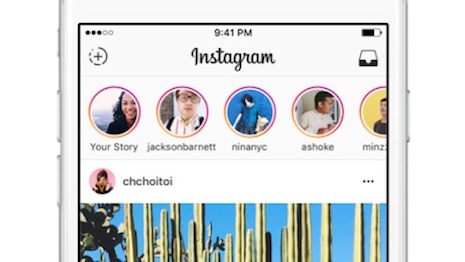 Instagram Stories. Image credit: Instagram
Instagram also has arguably the biggest share of influencers in social media with the majority of all influencer marketing coming from Instagram.
Brands have recognized the power of social media to influence their online consumers for some time, which is why many large corporations to small businesses have adopted some sort of social media into their overall marketing strategy.
Instagram is the frontrunner of social networks with more than 300 million monthly active users uploading 70 million photos and videos daily. As a result, more brands are putting money and resources behind creating campaigns that will appeal to their photo-crazed consumers (see story).
"Luxury brands should ensure that influencer marketing is done to help drive business forward, and not just checking a box because everyone’s doing it," said Brittany Richter, vice president and head of social media at iProspect, New York. "The first step is to ask not just who you are trying to influence, but who influences those people.
"Influencers don’t have to be celebrities or people with huge social followings," she said. "The most important thing is that they are opinion leaders for those you’re seeking to influence, and they have a following of people who are in the brand’s target audience.
"Secondly, be clear in what you’re trying to drive and accomplish, and align on what success looks like. Don’t let someone with a following make you think you work for them."
In fact, influencer marketing content routinely outperforms content from the brands themselves on Instagram.
Plus-sized model and social media influencer Iskra led the way for the top content coming out on Instagram from New York Fashion Week, as influencer content saw the most engagement well beyond designer content, according to Chute.
Michael Kors and Vogue were the luxury brands amongst the top content creators who saw the most engagement surrounding NYFW. Fashion Blogger was the top hashtag discussed in relation to Fashion Week, alluding to the rise of importance of fashion blogger Instagram influencers for NYFW (see story).
With this massive share of the inlfuencer market, Instagram offers the kind of authentic connection between brands and consumers that other platforms cannot quite match, making it a powerhouse in the world of social marketing.
Snap to it
Snapchat is the youngest of the four big social media platforms and also the one that has proved the hardest nut to crack for luxury brands.
According to L2’s "Omnichannel report on luxury shopping," most luxury brands are missing a huge opportunity to connect to an active audience as only 47 percent of brands posted in Snapchat last October (see story).
“Most luxury brands have not capitalized on social platforms for omnichannel initiatives—only 47 percent of luxury brands posted on Snapchat in October 2016 and mainly used the app to showcase products rather than encourage in-store visits, and only three luxury brands have implemented chatbots on Facebook Messenger,” said Evan Neufeld, sector lead at L2, New York.
When Snapchat, owned by Snap Inc., as it is now known, went public, predictions were split over how it would turn out, but the company’s stock has been performing poorly so far.
Instagram Stories. Image credit: Instagram
Instagram also has arguably the biggest share of influencers in social media with the majority of all influencer marketing coming from Instagram.
Brands have recognized the power of social media to influence their online consumers for some time, which is why many large corporations to small businesses have adopted some sort of social media into their overall marketing strategy.
Instagram is the frontrunner of social networks with more than 300 million monthly active users uploading 70 million photos and videos daily. As a result, more brands are putting money and resources behind creating campaigns that will appeal to their photo-crazed consumers (see story).
"Luxury brands should ensure that influencer marketing is done to help drive business forward, and not just checking a box because everyone’s doing it," said Brittany Richter, vice president and head of social media at iProspect, New York. "The first step is to ask not just who you are trying to influence, but who influences those people.
"Influencers don’t have to be celebrities or people with huge social followings," she said. "The most important thing is that they are opinion leaders for those you’re seeking to influence, and they have a following of people who are in the brand’s target audience.
"Secondly, be clear in what you’re trying to drive and accomplish, and align on what success looks like. Don’t let someone with a following make you think you work for them."
In fact, influencer marketing content routinely outperforms content from the brands themselves on Instagram.
Plus-sized model and social media influencer Iskra led the way for the top content coming out on Instagram from New York Fashion Week, as influencer content saw the most engagement well beyond designer content, according to Chute.
Michael Kors and Vogue were the luxury brands amongst the top content creators who saw the most engagement surrounding NYFW. Fashion Blogger was the top hashtag discussed in relation to Fashion Week, alluding to the rise of importance of fashion blogger Instagram influencers for NYFW (see story).
With this massive share of the inlfuencer market, Instagram offers the kind of authentic connection between brands and consumers that other platforms cannot quite match, making it a powerhouse in the world of social marketing.
Snap to it
Snapchat is the youngest of the four big social media platforms and also the one that has proved the hardest nut to crack for luxury brands.
According to L2’s "Omnichannel report on luxury shopping," most luxury brands are missing a huge opportunity to connect to an active audience as only 47 percent of brands posted in Snapchat last October (see story).
“Most luxury brands have not capitalized on social platforms for omnichannel initiatives—only 47 percent of luxury brands posted on Snapchat in October 2016 and mainly used the app to showcase products rather than encourage in-store visits, and only three luxury brands have implemented chatbots on Facebook Messenger,” said Evan Neufeld, sector lead at L2, New York.
When Snapchat, owned by Snap Inc., as it is now known, went public, predictions were split over how it would turn out, but the company’s stock has been performing poorly so far.
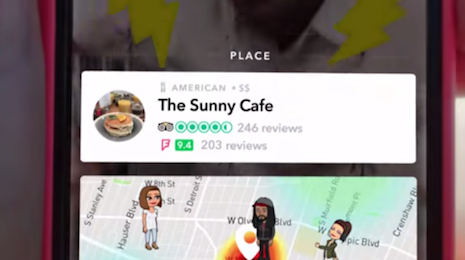 Snapchat provides added utility with Context Cards. Image credit: Snapchat
Luxury brands should not be hasty in jumping off the Snapchat wagon that was so full a few months ago depending on what kind of engagement they are trying to get out of the service (see story).
The difficulty comes from the fact that Snapchat is not as intuitively monetizable as some of the other platforms. While there is a direct connection between Facebook ads and conversions, Snapchat’s setup makes that a bit more difficult.
The platform has been working to change that, however.
Snapchat’s latest offering is opening the door for advertisers to have greater interaction and call-to-action strategies on user-generated content.
Snapchat is investing in another inventive advertising strategy that offers more information to consumers while benefiting marketers. Snapchat's newly launched Context Cards feature allows users to swipe up for more information regarding a snap, powered by advertisers such as TripAdvisor, Foursquare, Michelin and Goop (see story).
One of the biggest challenges for any social media platform when it comes to advertising is helping brands attribute digital ads to offline purchases in-store.
Snapchat is helping brands gain more perspective on how advertising on the application stimulates in-store visits with a new ad product.
“Snap to Store” is the new ad product from the app that allows ad partners to better track how well their campaigns are doing. Through data mining, Snapchat breaks down visitors based on demographics and how they interacted with the brand (see story).
With Snap to Store, brands will now have a deeper understanding of how their efforts on Snapchat are translating into real world sales.
Brands have taken notice of this new tool and have been working with it since its introuduction.
Last year, Italian fashion label Fendi counted down the days until Christmas through interactive stories on Snapchat and Instagram.
The brand’s #12DaysofFendi gave its followers tasks, such as decorating a Christmas tree or building a snowman, which could be completed by tapping their screen. Taking advantage of both platforms’ user interfaces, these stories give the illusion of participation to those watching, giving them a reason to stay through the end (see story).
Snapchat provides added utility with Context Cards. Image credit: Snapchat
Luxury brands should not be hasty in jumping off the Snapchat wagon that was so full a few months ago depending on what kind of engagement they are trying to get out of the service (see story).
The difficulty comes from the fact that Snapchat is not as intuitively monetizable as some of the other platforms. While there is a direct connection between Facebook ads and conversions, Snapchat’s setup makes that a bit more difficult.
The platform has been working to change that, however.
Snapchat’s latest offering is opening the door for advertisers to have greater interaction and call-to-action strategies on user-generated content.
Snapchat is investing in another inventive advertising strategy that offers more information to consumers while benefiting marketers. Snapchat's newly launched Context Cards feature allows users to swipe up for more information regarding a snap, powered by advertisers such as TripAdvisor, Foursquare, Michelin and Goop (see story).
One of the biggest challenges for any social media platform when it comes to advertising is helping brands attribute digital ads to offline purchases in-store.
Snapchat is helping brands gain more perspective on how advertising on the application stimulates in-store visits with a new ad product.
“Snap to Store” is the new ad product from the app that allows ad partners to better track how well their campaigns are doing. Through data mining, Snapchat breaks down visitors based on demographics and how they interacted with the brand (see story).
With Snap to Store, brands will now have a deeper understanding of how their efforts on Snapchat are translating into real world sales.
Brands have taken notice of this new tool and have been working with it since its introuduction.
Last year, Italian fashion label Fendi counted down the days until Christmas through interactive stories on Snapchat and Instagram.
The brand’s #12DaysofFendi gave its followers tasks, such as decorating a Christmas tree or building a snowman, which could be completed by tapping their screen. Taking advantage of both platforms’ user interfaces, these stories give the illusion of participation to those watching, giving them a reason to stay through the end (see story).
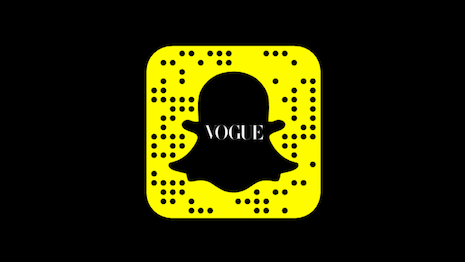 Vogue's partnership with Snapchat. Image credit: Vogue
Similarly, Fendi also took inspiration from its whimsical Bag Bug charms for interactive storytelling.
The house tapped the skip ahead feature on Instagram and Snapchat Stories to let consumers control the Bag Bugs’ actions as they look for their "home" on a handbag. This approach to mobile marketing took away passive viewing, allowing Fendi to potentially work around consumers' shrinking attention spans (see story).
Other brands have strayed away from Snapchat Stories and embraced Snapchat Discover, the tab where brands have the most freedom to create branded content on the platform.
Condé Nast-owned British Vogue is the latest of the Vogue-branded magazines to launch on Snapchat Discover as publishers look to amplify their digital efforts.
Vogue is currently pushing a Snapchat Discover strategy across the markets where its publications are present to take its editorial voice from print pages to the mobile content space. Vogue’s publisher has invested heavily in digital recently to ensure its titles stay modern and are fluid in an evolving print landscape (see story).
While brands are still figuring out the best way to monetize Snapchat and connect ads to physical purchases, the platform has been steadily adding new tools to make brands’ lives easier.
Other platforms
Few social media platforms have the reach and influence of Facebook, Twitter, Instagram and Snapchat, but others still serve by filling the gaps between the big four.
For example, Pinterest has built a solid platform for luxury brands by connecting consumers’ inspirational and aspirational posts to shoppable pages for the brands that post that content.
On Pinterest, luxury campaigns are dominant compared to mass brands, generating 17 percent more engagements per pin, 32 percent more repins per pin and 59 percent more likes per pin.
Luxury’s dominance on Pinterest also extended to the wedding sector, where luxury-branded wedding posts received 46 percent more engagements per pin than non-luxury-branded wedding posts (see story).
Part of Pinterest’s success can be traced to the way it merges social media and commerce.
Vogue's partnership with Snapchat. Image credit: Vogue
Similarly, Fendi also took inspiration from its whimsical Bag Bug charms for interactive storytelling.
The house tapped the skip ahead feature on Instagram and Snapchat Stories to let consumers control the Bag Bugs’ actions as they look for their "home" on a handbag. This approach to mobile marketing took away passive viewing, allowing Fendi to potentially work around consumers' shrinking attention spans (see story).
Other brands have strayed away from Snapchat Stories and embraced Snapchat Discover, the tab where brands have the most freedom to create branded content on the platform.
Condé Nast-owned British Vogue is the latest of the Vogue-branded magazines to launch on Snapchat Discover as publishers look to amplify their digital efforts.
Vogue is currently pushing a Snapchat Discover strategy across the markets where its publications are present to take its editorial voice from print pages to the mobile content space. Vogue’s publisher has invested heavily in digital recently to ensure its titles stay modern and are fluid in an evolving print landscape (see story).
While brands are still figuring out the best way to monetize Snapchat and connect ads to physical purchases, the platform has been steadily adding new tools to make brands’ lives easier.
Other platforms
Few social media platforms have the reach and influence of Facebook, Twitter, Instagram and Snapchat, but others still serve by filling the gaps between the big four.
For example, Pinterest has built a solid platform for luxury brands by connecting consumers’ inspirational and aspirational posts to shoppable pages for the brands that post that content.
On Pinterest, luxury campaigns are dominant compared to mass brands, generating 17 percent more engagements per pin, 32 percent more repins per pin and 59 percent more likes per pin.
Luxury’s dominance on Pinterest also extended to the wedding sector, where luxury-branded wedding posts received 46 percent more engagements per pin than non-luxury-branded wedding posts (see story).
Part of Pinterest’s success can be traced to the way it merges social media and commerce.
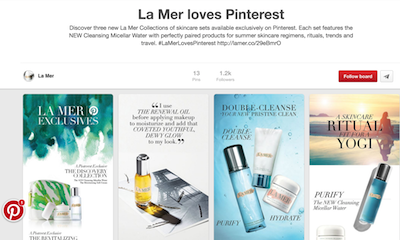 The La Mer loves Pinterest board. Image credit: La Mer
With the buy button struggling on social media, Pinterest is exploring a different way of capturing the buying opportunity on mobile with a new shopping bag that spans multiple platforms.
Pinterest knows it has a huge opportunity to target consumers with options to purchase, as users are often on its platform to look for products and ideas. Now, users will be able to purchase items featured on Pinterest on the Web, as well as on their mobile devices, and add them to a bag to complete multiple purchases, along with a checkout feature to compete with PayPal and Apple Pay that saves users’ information (see story).
Brands have embraced the tools provided by Pinterest.
Estée Lauder Cos.’ Crème de la Mer digitally recreated the word-of-mouth phenomenon that made its products cult favorites through a co-branded campaign.
La Mer’s success has been built on verbal recommendations since its start, and social media has assisted in continuing the tradition, with consumers often turning to digital platforms to peer review products. The social inspiration board application Pinterest has emerged as the ideal platform for sharing favorite products and discovering new ones and has been recently outfitted with ecommerce capabilities (see story).
Outside of the U.S., China is one of the biggest luxury consuming nations in the world. For Chinese consumers, WeChat is one of the biggest social media platforms and brands that seek to engage with Chinese customers have already begun running campaigns on it.
For instance, collaborating with Tencent and DLG China, Swarovski is the first watch and jewelry brand to leverage mini programs to innovate on social commerce, highlighting its recent Mother’s Day campaign.
Since launching in early January, WeChat mini programs offer brands an alternate avenue to develop advanced functionalities, whether it is making purchases, finding up-to-the-minute information or editing photos (see story).
Swiss watchmaker Roger Dubuis and Italian tire manufacturer and motorsport sponsor Pirelli launched a new campaign through China’s popular ecommerce and social media hybrid WeChat.
The La Mer loves Pinterest board. Image credit: La Mer
With the buy button struggling on social media, Pinterest is exploring a different way of capturing the buying opportunity on mobile with a new shopping bag that spans multiple platforms.
Pinterest knows it has a huge opportunity to target consumers with options to purchase, as users are often on its platform to look for products and ideas. Now, users will be able to purchase items featured on Pinterest on the Web, as well as on their mobile devices, and add them to a bag to complete multiple purchases, along with a checkout feature to compete with PayPal and Apple Pay that saves users’ information (see story).
Brands have embraced the tools provided by Pinterest.
Estée Lauder Cos.’ Crème de la Mer digitally recreated the word-of-mouth phenomenon that made its products cult favorites through a co-branded campaign.
La Mer’s success has been built on verbal recommendations since its start, and social media has assisted in continuing the tradition, with consumers often turning to digital platforms to peer review products. The social inspiration board application Pinterest has emerged as the ideal platform for sharing favorite products and discovering new ones and has been recently outfitted with ecommerce capabilities (see story).
Outside of the U.S., China is one of the biggest luxury consuming nations in the world. For Chinese consumers, WeChat is one of the biggest social media platforms and brands that seek to engage with Chinese customers have already begun running campaigns on it.
For instance, collaborating with Tencent and DLG China, Swarovski is the first watch and jewelry brand to leverage mini programs to innovate on social commerce, highlighting its recent Mother’s Day campaign.
Since launching in early January, WeChat mini programs offer brands an alternate avenue to develop advanced functionalities, whether it is making purchases, finding up-to-the-minute information or editing photos (see story).
Swiss watchmaker Roger Dubuis and Italian tire manufacturer and motorsport sponsor Pirelli launched a new campaign through China’s popular ecommerce and social media hybrid WeChat.
 Three lucky customers could purchase the Excalibur Spider Pirelli watch early through WeChat. Image credit: Roger Dubuis
Customers will have the chance to purchase the new Excalibur Spider Pirelli watch from Roger Dubuis prior to the timepiece's full release. In keeping with Pirelli’s motorsport theme, customers had a limited time to activate the purchase and only the three fastest WeChat users were able to purchase a watch before it became widely available (see story).
These platforms, Pinterest and WeChat, along with others such as Tumblr and YouTube, are used far less often than the dominant platforms of the day, but they are still important to note and understand as they round out the full extent of the social world.
Social conclusions
From Twitter to Facebook, from influencers to branded stories, social media has fundamentally changed the way brands and marketers interact with customers.
As consumers continually live the majority of their digital lives on these massive platforms, the responsibility for brands will be to make sure they are able to communicate with those consumers in a way and through a medium that they fully understand.
While the number of major social media platforms may be small, one of the most important things for brands to remember is to keep their messaging consistent across the different platforms so that the consumer-brand conversation is consistent and relatable.
“Use your different social channels and marketing mediums, in general, to tell one consistent, cohesive story about the brand, but in different formats based on the channel," Honigman Media's Mr. Honigman said.
"A luxury brand is defined by the feelings it invokes. You have to make people experience what you want them to feel with your use of video on Facebook, conversational text on Twitter and curated visuals on Instagram and behind the scenes with Instagram stories,” he said.
Best-practice tips for social media:
Three lucky customers could purchase the Excalibur Spider Pirelli watch early through WeChat. Image credit: Roger Dubuis
Customers will have the chance to purchase the new Excalibur Spider Pirelli watch from Roger Dubuis prior to the timepiece's full release. In keeping with Pirelli’s motorsport theme, customers had a limited time to activate the purchase and only the three fastest WeChat users were able to purchase a watch before it became widely available (see story).
These platforms, Pinterest and WeChat, along with others such as Tumblr and YouTube, are used far less often than the dominant platforms of the day, but they are still important to note and understand as they round out the full extent of the social world.
Social conclusions
From Twitter to Facebook, from influencers to branded stories, social media has fundamentally changed the way brands and marketers interact with customers.
As consumers continually live the majority of their digital lives on these massive platforms, the responsibility for brands will be to make sure they are able to communicate with those consumers in a way and through a medium that they fully understand.
While the number of major social media platforms may be small, one of the most important things for brands to remember is to keep their messaging consistent across the different platforms so that the consumer-brand conversation is consistent and relatable.
“Use your different social channels and marketing mediums, in general, to tell one consistent, cohesive story about the brand, but in different formats based on the channel," Honigman Media's Mr. Honigman said.
"A luxury brand is defined by the feelings it invokes. You have to make people experience what you want them to feel with your use of video on Facebook, conversational text on Twitter and curated visuals on Instagram and behind the scenes with Instagram stories,” he said.
Best-practice tips for social media:
- Brian Honigman, CEO of Honigman Media
- "Include your customers as much as possible so they are involved with the brand like they have a stake in the latest campaign or collection. People love to be acknowledged even by a brand they like. Think about that when communicating with customers."
- Brittany Richter, vice president and head of social media at iProspect
- "Incorporate motion in your ad units to ensure that it is thumb-stopping and draws the consumer in."
- "Don’t be afraid of things like Dynamic Product Ads or other traditionally DR-heavy tactics. There are ways to customize every execution to balance product and direct-response with luxury messaging."
- Andrea Wilson, vice president/strategy director and luxury practice lead at iProspect
- "Each social platform has different users, consumption patterns and consumer mindsets, so don’t replicate the same creative across everything. Tell the same overarching story, but make the creative unique and relevant for each platform."
- "Honor the consumer path and social’s role in it. For example, don’t de-prioritize social because you don’t see immediate online conversions. Ask your customers how they use social and create campaigns that aid their journey."
